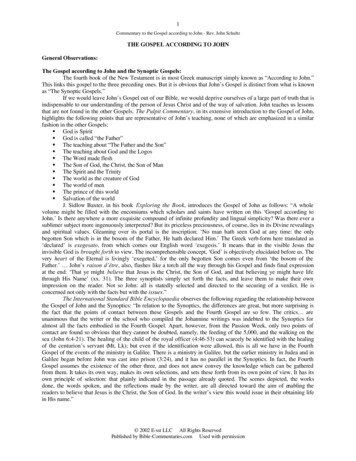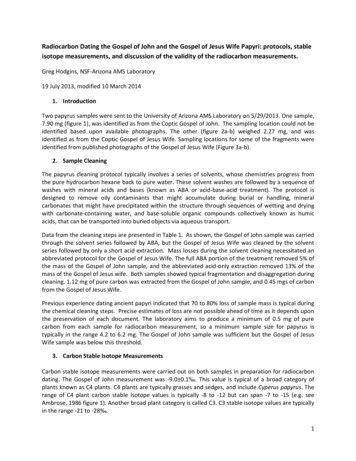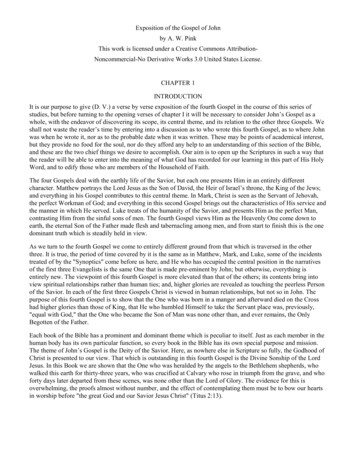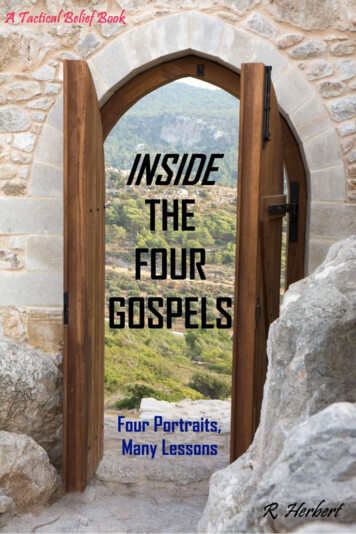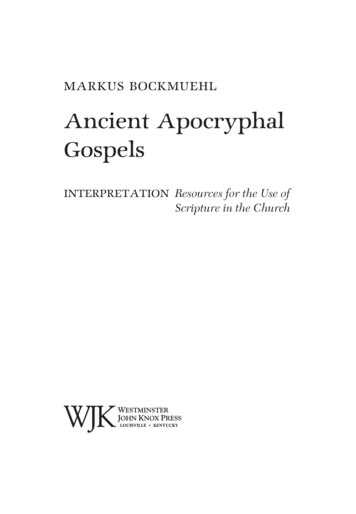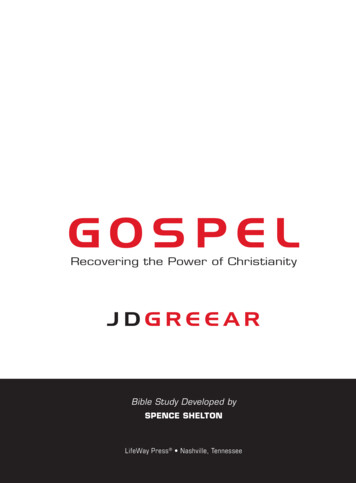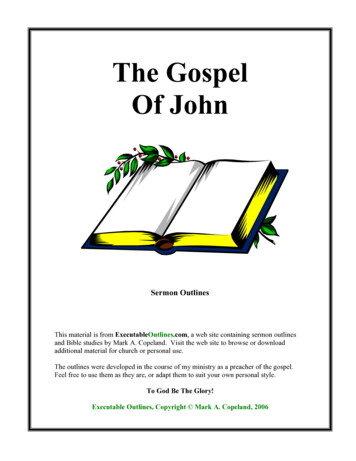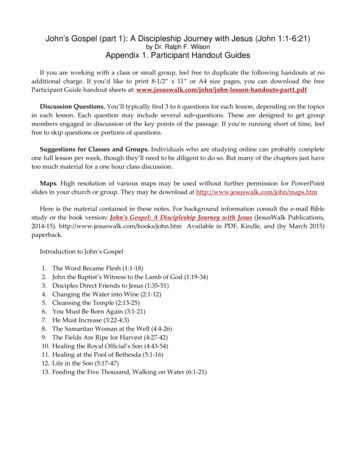
Transcription
John’s Gospel (part 1): A Discipleship Journey with Jesus (John 1:1-6:21)by Dr. Ralph F. WilsonAppendix 1. Participant Handout GuidesIf you are working with a class or small group, feel free to duplicate the following handouts at noadditional charge. If you’d like to print 8‐1/2” x 11” or A4 size pages, you can download the freeParticipant Guide handout sheets at: part1.pdfDiscussion Questions. You’ll typically find 3 to 6 questions for each lesson, depending on the topicsin each lesson. Each question may include several sub‐questions. These are designed to get groupmembers engaged in discussion of the key points of the passage. If you’re running short of time, feelfree to skip questions or portions of questions.Suggestions for Classes and Groups. Individuals who are studying online can probably completeone full lesson per week, though they’ll need to be diligent to do so. But many of the chapters just havetoo much material for a one hour class discussion.Maps. High resolution of various maps may be used without further permission for PowerPointslides in your church or group. They may be download at http://www.jesuswalk.com/john/maps.htmHere is the material contained in these notes. For background information consult the e‐mail Biblestudy or the book version: John’s Gospel: A Discipleship Journey with Jesus (JesusWalk Publications,2014‐15). http://www.jesuswalk.com/books/john.htm Available in PDF, Kindle, and (by March 2015)paperback.Introduction to John’s Gospel1.2.3.4.5.6.7.8.9.10.11.12.13.The Word Became Flesh (1:1‐18)John the Baptist’s Witness to the Lamb of God (1:19‐34)Disciples Direct Friends to Jesus (1:35‐51)Changing the Water into Wine (2:1‐12)Cleansing the Temple (2:13‐25)You Must Be Born Again (3:1‐21)He Must Increase (3:22‐4:3)The Samaritan Woman at the Well (4:4‐26)The Fields Are Ripe for Harvest (4:27‐42)Healing the Royal Official’s Son (4:43‐54)Healing at the Pool of Bethesda (5:1‐16)Life in the Son (5:17‐47)Feeding the Five Thousand, Walking on Water (6:1‐21)
John’s Gospel: A Discipleship Journey with Jesus (part 1)2Introduction to John’s GospelJohn’s Gospel is dramatically different than the Synoptic Gospels (meaning similar Gospels, “pre‐senting the same view”) – Matthew, Mark, and Luke. These first three Gospels share, to some degree, asimilar source, and often have passages that seem almost the same word‐for‐word as in the others.But John’s Gospel is in a class by itself. It draws upon a separate, independent gospel tradition. It’sas if the Synoptic Gospels tell the story of Jesus’ life, miracles, parables, and teaching, letting readersdraw their own conclusions. But John is very selective in the events he includes. And when he doesinclude a miracle, he often leads us to ponder its meaning in a discourse. John’s Gospel, written late inthe apostle’s life, is full of thoughtful, theological reflection.Authorship. The nearly unanimous tradition of the early church is that John the Apostle, son ofZebedee, is the author of the Gospel that bears his name. And editor records, “. The disciple whomJesus loved . this is the disciple who testifies to these things and who wrote them down.” (21:20, 24).It’s quite clear that this was John the Apostle.Most scholars see the date of John’s Gospel as comparatively late, probably in the 90s AD. Johnseems to assume that his readers are acquainted with the facts of Jesus as given in the SynopticGospels. Several early traditions place the Apostle John as Bishop of Ephesus at the end of his life. Johnprobably penned his Gospel in Ephesus.Purpose. “These are written that you may believe that Jesus is the Christ, the Son of God, and thatby believing you may have life in his name” (John 20:30‐31). John seems to have an evangelisticpurpose that guides his selection of material. John probably wrote to convince unbelieving Greek‐speaking Jews and Gentiles.John and the Synoptics. Differences from the Synoptic Gospels include John’s longer discourses,rather than parables and brief sayings; A focus on eternal life more than on the Kingdom of God; fewermiracles, but an emphasis on them as “signs” of who Jesus is; a strongly theological prologue, thatbegins by telling us just who Jesus is; no Christian baptism or sacraments mentioned; ministryprimarily in Judea and Jerusalem, with less on his Galilean ministry; a focus on Jewish feasts, especiallyon the Passover; and an emphasis on the tragedy of Jesus’ rejection by his own people and theirleaders.Theology. John is an intensely theological book. Some of the strongest themes include: the Jesus asthe Word or Logos, God as Father, the “I Am” sayings, Jesus as Son of God, Jesus as the Christ, miraclesigns and their relationship to true faith, salvation, life – especially eternal life, and the Holy Spirit asParaclete.Style. John’s style includes (1) purposeful twofold or double meanings; (2) misunderstanding, whereJesus is speaking on the heavenly level, but he is misunderstood as speaking to a material or earthlysituation; irony in derogatory statements by Jesus’ enemies; and explanatory notes.Copyright 2014, Ralph F. Wilson. All rights reserved. Permission is granted to reprint these notes for local churches, classes, and groups.Taken from Ralph F. Wilson, John’s Gospel: A Discipleship Journey with Jesus (JesusWalk, 2014‐15). www.jesuswalk.com/books/john.htm
John’s Gospel: A Discipleship Journey with Jesus (part 1)3“The Jews” in John’s Gospel. Most of the Synoptic Gospels use the term “the Jews” rarely, andusually in the phrase “King of the Jews.” However, John’s Gospel uses it 70 times. The adjectiveIoudaios is literally, “Judean.” John seems to use it to describe Jews of the Judean area – speaking fromthe perspective of a Galilean, usually to refer to the Jewish leaders from Judea who are hostile to Jesus.Religious Leaders in Jesus’ Day.1. Pharisees belonged to a lay movement or party that defined righteousness as observing everydetail of traditional rules designed to serve as a “hedge” or “fence” around the commandmentsin the Torah or Pentateuch, akin to modern‐day Hasidic Jews.2. High priests were appointed by Herod, and served at the pleasure of the Roman Governor, sothe high priests were often closely aligned with Roman interests.3. Sadducees were a group closely identified with the priestly aristocracy. They rejected the orallaw or “traditions of the elders,” and held rather to the Torah itself. They denied the resurrec‐tion and angels or spirits.4. “Scribes” (KJV) or “teachers of the law” (NIV) were a class of professional exponents andteachers of the law, either Sadducees or Pharisees. They were respected teachers who often hadpupils who studied the law with them.5. “Lawyers” (KJV) or “experts in the law” (NIV) is another word for “scribe.”6. “Rabbi” (KJV and NIV) is a respectful form of address for all teachers that means, literally,“great one.” In Jesus’ day it was not yet a fixed title for academically schooled, ordained scribesas it became later, and is in our day.7. “Teacher” (NIV) or “master” (KJV), usually translates the Hebrew/Aramaic word rabbi.Where it was possible, the Romans would have had a provincial governor who represented Romanauthority, but sought to keep in place the local kingdoms and administrative systems that were nativeto a country (client kingdoms or vassals). The Romans had ruled Israel since 36 BC, recognizing Herodthe Great as King of the Jews. After Herod’s death his kingdom was divided into four tetrarchies, eachruled by one of his sons. During Jesus’ time, Herod Antipas was tetrarch over Galilee, who beheadedJohn the Baptist, and before whom Jesus appeared at his trial.While the Romans and Herodian kings held civil power, the Jewish Sanhedrin acted as a rulingbody for the Jewish people. The “Great Sanhedrin” in Jerusalem consisted of 71 members (Exodus 24:1;Numbers 11:16, 24‐25), though lesser decisions could be made by a panel of 23 members. In Jesus’ day,the Great Sanhedrin functioned as both a supreme court, as well as legislature, and was made up ofmembers of the nobility (Sadducees, both priestly and lay), and scholars in the law (mainly Pharisees).Copyright 2014, Ralph F. Wilson. All rights reserved. Permission is granted to reprint these notes for local churches, classes, and groups.Taken from Ralph F. Wilson, John’s Gospel: A Discipleship Journey with Jesus (JesusWalk, 2014‐15). www.jesuswalk.com/books/john.htm
John’s Gospel: A Discipleship Journey with Jesus (part 1)41. The Word Became Flesh (John 1:1-18)“Word,” logos is “the independent personified expression of God.”Q1. (John 1:1‐3) According to the Apostle John, is Jesus fully God? What does it mean that Jesus isthe “Word”? What does this say about him and his ministry?In Genesis 1:3, light is created by God’s Word:John introduces the theme of a war between spiritual light and darkness that pervades his Gospel(John 1:4‐5, 7‐9; 3:19‐21; 8:12; 9:5; 11:9‐10; 12:35‐36, 46).John the Baptist was: Jesus’ cousin, just about six months older than Jesus (Luke 1:36‐66).Lived in the desert (Luke 1:80; 3:2).Ministered along the Jordan River east of Jerusalem “preaching a baptism of repentance for theforgiveness of sins” (Luke 3:3).Attracted a large following from Jerusalem and Judea (Matthew 3:5; Mark 1:5).Denounced the religious hypocrites (Luke 3:7‐8).Demanded love and justice of those who sought baptism (Luke 3:10‐14).Proclaimed that one who came after him would baptize with the Holy Spirit and fire (Luke 3:16‐17).Rebuked Herod Antipas, Tetrarch of Galilee and Perea, for adultery and incest, and was im‐prisoned (Luke 3:19‐20) and later beheaded because of the tetrarch’s wife Herodias’s anger atJohn’s rebuke (Matthew 14:3‐12).Baptized Jesus (Luke 3:21).Was widely considered to be a prophet (Mark 11:32), and declared to be one by Jesus (Matthew11:9).A Nazirite (Luke 1:15; Matthew 11:18).A righteous and holy man (Mark 6:20).Jesus said that he fulfilled the prophecy that Elijah should return (Matthew 17:12‐13; Mark 9:13).Q2. (John 1:7‐8) What did it mean that John was sent to “testify” to the light? In what sense are youput here with the purpose of “testifying” to the light? How are you doing in this regard? Whathappened to John the Baptist? What might happen to you if you testify clearly? What might happento the people to whom you testify?Q3 (John 1:12‐13) What does it mean to “receive” Jesus? What does it imply to “believe in” Jesus?What is the spiritual relationship to God of those who receive and believe in Jesus? Of those who donot?“One and Only” (NIV), “only Son” (ESV, NRSV), “only begotten” (KJV) is the adjective monogenēs,“one and only, only.” Here, “pertaining to being the only one of its kind or class, unique (in kind),” ofsomething that is the only example of its category.Copyright 2014, Ralph F. Wilson. All rights reserved. Permission is granted to reprint these notes for local churches, classes, and groups.Taken from Ralph F. Wilson, John’s Gospel: A Discipleship Journey with Jesus (JesusWalk, 2014‐15). www.jesuswalk.com/books/john.htm
John’s Gospel: A Discipleship Journey with Jesus (part 1)5Q4. (John 1:14) Why is the idea of God “becoming flesh” so important to the basis of the Christianfaith? What would Christ’s life, crucifixion, and resurrection mean if he were only pretending to“become flesh”? In what ways have you personally experienced his grace? In what ways has histruth changed your life from what it was?Q5. (John 1:18) What does it mean that Jesus is the “Only God” or the “Only Begotten God”? Doesthe Apostle John seem to make a distinction between God the Father and God the Son? What doesall this mean for our understanding of the Trinity?Lessons for Disciples1.2.3.4.5.6.7.8.9.Jesus is fully divine. He is God (1:1).Jesus is the full expression of God the Father (1:1).Jesus is not a created being, rather he was delegated the task of creation (1:2‐3).Jesus is the source of life and truth for mankind (1:4).Jesus was rejected by his own people (1:11).Only those who believe and receive Jesus have “authority” to be called God’s children (1:12).Jesus (the Word) became human (flesh) and showed us God’s glory (1:14).Jesus brings grace and truth (1:14, 17).Jesus is the One and Only God (1:18).Key Verses: John 1:1‐3; 1:11‐13; 1:14; 1:18,Copyright 2014, Ralph F. Wilson. All rights reserved. Permission is granted to reprint these notes for local churches, classes, and groups.Taken from Ralph F. Wilson, John’s Gospel: A Discipleship Journey with Jesus (JesusWalk, 2014‐15). www.jesuswalk.com/books/john.htm
John’s Gospel: A Discipleship Journey with Jesus (part 1)62. John the Baptist’s Witness to the Lamb of God (John 1:19-34)John the Baptist seems to have been well known in Jewish circles as a revivalist. Josephus recordsseveral paragraphs about him (Josephus, Antiquities, xviii. 5.2). Peter refers to John the Baptist as hepreaches about Jesus in the Roman city of Caesarea. Paul speaks of him in a synagogue in PisidianAntioch on his first missionary journey (Acts 13:24). Even as far away as Ephesus in about 52 AD, Paulfinds a zealous Jew from Alexandria who “knows only the baptism of John” (Acts 18:25).People wondered if he were:1. The Messiah or Christ.2. Elijah. (Malachi 4:5)3. The Prophet referred to by Moses (Deuteronomy 18:15).Q1. (John 1:19‐23) Why do you think John the Baptist was being hassled by the religious leadersfrom Jerusalem? What were they afraid of? How did John understand his own mission? How muchconflict do you think could be expected from John’s mission?Q2. (John 1:26‐27) Why did John baptize? What is the meaning of the baptism he was performing?What do you think baptism represents to those John baptized?Q3. (John 1:19‐27) How does John the Baptist show humility? How can a person see himself as thefulfillment of a passage from Isaiah and still be humble about it? How does John see himself inrelation to the coming Messiah? How can a person be such a strong revivalist preacher and stillremain humble? Can humility and powerful, confident speech co‐exist?Q4. (John 1:29) What does the title “Lamb of God” tell us about Jesus’ ministry? According to 1:29,whose sins did he come to take away? In what ways did Jesus fulfill Isaiah 53?Ways John describes the coming of the Holy Spirit using various analogies and figures: “Born of the Spirit” (3:6, 8), “born from above/again” (3:6).Worship “in Spirit and in truth” (4:24).“Rivers of living water” flowing out of one’s heart (7:38‐39), offered to “whoever believes inme.”“The Spirit of truth,” who is with you and will be in you (14:16‐17) – another Counselor(Greek Paraklētos), the indwelling Spirit.The Spirit (Paraklētos) who will teach and remind believers of what Jesus said (14:26).The Spirit (Paraklētos) who testifies of Jesus (15:26).The Spirit (Paraklētos) who will guide us into all truth (16:13‐15), and who will convict theworld of sin (16:8‐11).The Spirit Whom Jesus breathed upon his disciples – “Receive the Holy Spirit” (20:22).Copyright 2014, Ralph F. Wilson. All rights reserved. Permission is granted to reprint these notes for local churches, classes, and groups.Taken from Ralph F. Wilson, John’s Gospel: A Discipleship Journey with Jesus (JesusWalk, 2014‐15). www.jesuswalk.com/books/john.htm
Q5. (John 1:33) How does John the Baptist’s baptism differ from the baptism that Jesus brings?Baptism is a word that means “immerse, plunge under water.” What does a “baptism of the HolySpirit” imply about this event?Lessons for Disciples1. John humbly and faithfully fulfilled his mission, which he saw clearly enough, even though hemay not have fully understood how he fit into God’s plan (1:23).2. Jesus is the “Lamb of God,” God’s sacrifice for our sins, prophesied in Isaiah 53 and fulfilled onthe cross. Jesus’ mission was to take away our sins (1:29).3. John realizes that his job is to reveal Christ to Israel – and he’s okay about that, even though hedoesn’t get to take the glory for himself (1:30).4. Jesus baptizes with the Holy Spirit, that is, he floods people with his Holy Spirit (1:33).5. Jesus is the Son of God (1:34).Key Verses ‐ John 1:26‐27; 1:29; 1:34
John’s Gospel: A Discipleship Journey with Jesus (part 1)83. Disciples Direct Friends to Jesus (John 1:35-51)Q1. (John 1:35‐37) Upon whose recommendation did Andrewand another person start following Jesus? What did thisrecommendation cost the recommender in this case?Q2. (John 1:38‐39) Why doesn’t Jesus tell his inquirers wherehe is staying? Why was it important for disciples to “be with”Jesus? What does “being with” Jesus mean today?Q3. (John 1:40‐42) What role does Andrew play in SimonPeter’s conversion? Today, why do so many Christianssubstitute bringing a person to Jesus with bringing them tochurch? What might be the similarities? What might be the differences?Jesus seems to have been exercising what is sometimes referred to as the “word of knowledge” (1Corinthians 12:8), some kind of supernatural prophetic insight into a person’s life or needs, somethinglike an ancient “seer” might have. This gift in our day can result in faith and salvation. Let’s honor it inour churches and not neglect it. Jesus is our exemplar in this.Q4. (John 1:45‐50) How does Jesus deal with Nathanael’s skepticism? What was the nature of themiracle? Upon coming to faith, what title does Nathanael bestow upon Jesus?Q5. (John 1:50‐51) Which aspects of Daniel’s prophecy in Daniel 7:13‐14 does Jesus apply to his titleas Son of Man? When will the Son of Man complete his 401‐q5‐son‐of‐man/Lessons for Disciples1. Friends often become disciples by being pointed to Jesus by their friends. It is a natural way ofbecoming a disciple. We must trust our friends to Jesus, rather than keep them for ourselveswithout “ruining” a friendship by mentioning “religion.”2. Jesus is called by several titles in this passage: Messiah (Christ, 1:41), Son of God (1:49), King ofIsrael (1:49), and Son of Man (1:51).3. Jesus exercises the “spiritual gift” of the “word of knowledge” (1 Corinthians 12:8) to convincepeople of who he is. We need to draw on spiritual gifts to convince people of who Jesus is.4. Jesus gives Peter a “new name” that signifies what his future role will be. God may have somerole for you that is far beyond what you can imagine.Key Verses ‐ John 1:37‐39a; 1:41‐42a; 1:42b; 1:51.Copyright 2014, Ralph F. Wilson. All rights reserved. Permission is granted to reprint these notes for local churches, classes, and groups.Taken from Ralph F. Wilson, John’s Gospel: A Discipleship Journey with Jesus (JesusWalk, 2014‐15). www.jesuswalk.com/books/john.htm
John’s Gospel: A Discipleship Journey with Jesus (part 1)94. Changing the Water into Wine (John 2:1-12)Marriage in Jesus’ day begins with a betrothal up to a yearbefore the marriage celebration. The man and woman enterinto a binding agreement to marry, more binding than our“engagement” in the West. The man gives the bride’s father abridal gift, a form of compensation to the father (some ofwhich becomes a dowry the father gives to the daughter at themarriage to help provide economic stability to the marriagebond). The couple doesn’t live together or consummate themarriage at their betrothal, though they are consideredhusband and wife, and the bond cannot be broken withoutdivorce.A marriage in this culture is a celebration. The groom and his friends go to the bride’s home, andthen escort the bride in a festive procession to the groom’s home, where a grand celebration takesplace. There is probably an exchange of vows and some kind of religious ceremony, though none ofthese details survive from the first century AD. The groom gives his bride gifts. After the marriagefeast, the bride and groom enter the nuptial chamber and the marriage is consummated.Q1. (John 2:1‐2) Why are we sometimes “too busy” to spend time with friends and relatives? Whatdoes Jesus’ attendance at this wedding tell us about him? How can we apply that learning in ourown personal lives?Throughout the Gospels, we see Jesus’ clear awareness that he must not plunge into fame tooquickly. That is why he tells people on certain occasions not to tell everybody about their miracle (Mark1:43‐45; 7:36) or that he is the Messiah (Mark 8:29‐30 Matthew 16:20; Mark 9:9 Luke 9:36 Matthew17:9). His hour had not yet come, and manipulating publicity would force that “hour” to come beforehe can train his disciples for their Kingdom work. Jesus’ eyes were clearly on his chief purpose, but heisn’t in a hurry. There is no rush.Q2. (John 2:3‐5) Why do you think Mary pushes Jesus to solve the wedding host’s problem? Are herwords to Jesus appropriate? Would you categorize Jesus’ reply as a rebuke? If so, why does he goahead with the miracle?In the so‐called “Burnt House” in the Jewish Quarter of the Old City of Jerusalem, archaeologistsfound several stone water jars from the first century AD. They are 2 to 2.5 feet high (65‐80 cm.), shapedfrom limestone on some kind of very large lathe. They held about 17 gallons (80 liters), and werecovered by a flat piece of stone. In Capernaum, several stone jars from the fourth century AD have beenfound in the synagogue there. See Mark 7:3‐4.Q3. (John 2:6‐10) Why do you think alcoholics are quick to point out this miracle? Which is wrong:drinking wine or drunkenness? How can we avoid excesses and still enjoy God’s good gifts?Copyright 2014, Ralph F. Wilson. All rights reserved. Permission is granted to reprint these notes for local churches, classes, and groups.Taken from Ralph F. Wilson, John’s Gospel: A Discipleship Journey with Jesus (JesusWalk, 2014‐15). www.jesuswalk.com/books/john.htm
John’s Gospel: A Discipleship Journey with Jesus (part 1)10Q4. (John 2:6‐10) Why did Jesus perform this miracle behind‐the‐scenes? Who was he trying toprotect? What does the quantity of the wine tell us about Jesus’ glory? What does the quality of thewine tell us about Jesus’ glory?“Miraculous signs” (NIV), “signs” (NRSV), “miracles” (KJV) is the plural of sēmeion, “a sign ordistinguishing mark whereby something is known, sign, token, indication.” Here, “an event that is anindication or confirmation of intervention by transcendent powers, miracle, portent.” Sēmeion is one ofthe characteristic words used in John (2:11, 18; 4:54; 6:2, 14, 26, 30; 7:31; 9:16; 10:41; 11:47; 12:18, 37;20:30).Lessons for Disciples1. Celebrations with family and friends are important to Jesus – and should be to us. We shouldn’tfeel ourselves too spiritual or too busy for such earthly joys and responsibilities.2. It’s possible to try to push God into acting on our behalf. It’s best to be less pushy than Jesus’mother, or we may be rebuked like she was.3. Jesus is not against wine. It’s drunkenness that is wrong, the misuse of God’s gifts, not wineitself.4. Miracles need not be showy or even trumpeted to others. To meet the need is enough. Jesus wasnot a showman.Key Verses ‐ John 2:3‐5; 2:10.Copyright 2014, Ralph F. Wilson. All rights reserved. Permission is granted to reprint these notes for local churches, classes, and groups.Taken from Ralph F. Wilson, John’s Gospel: A Discipleship Journey with Jesus (JesusWalk, 2014‐15). www.jesuswalk.com/books/john.htm
John’s Gospel: A Discipleship Journey with Jesus (part 1)115. Cleansing the Temple (John 2:13-25)The first temple was built by Solomon on Mount Moriah in Jerusalem about 950 BC to replace thetabernacle that had been Israel’s portable place of worship, first in the wilderness at Sinai and for thenext several hundred years at Shiloh.Solomon’s Temple was destroyed in 587 BCwhen Nebuchadnezzar’s army destroyedJerusalem. The next temple was built when theJews returned from exile under Zerubbabel inabout 515 BC. It was damaged, plundered, anddesecrated by Greek conqueror AntiochusEpiphanes in 167 BC and later by Romangenerals Pompey in 63 BC and Crassus in 54BC. Herod the Great destroyed some of thetemple walls as he stormed Jerusalem in 37 BC.Herod the Great, now King of the Jewsunder the Romans, began to rebuild the templein 20‐19 BC, a process that continued for mostof the next decade, with further ornamentationcontinuing perhaps through the 60s AD (cf.2:20). Since Herod’s Temple was constructedover the foundation of the temple built underZerubbabel in 515 BC (though greatly expanded), it is known by Jews today as the Second Temple.Remnants of this temple are still visible today in the Wailing Wall at the base of its Western Wall.Court of the Gentiles was the outermost court. Jesus and his disciples – and later the early church –met under Solomon’s Porch on the east side of the temple complex (10:23; Acts 3:11; 5:12). Gentiles aswell as Jews were allowed to be there. Here sacrificial animals were sold and money exchanged.Court of Women was divided from the Court of the Gentiles by a stone balustrade, perhaps 4.5 feethigh, where women, but not Gentiles, could come and pray.Courts of Israel and of the Priests were accessible from the Nicanor Gate on the west side of theCourt of Women. Within the Court of the Priests were the altar, laver, various chambers, and theTemple building itself.Temple Building. The front of the temple building was 150 feet wide and high, a gilded spectaclethat was the wonder of all. The Second Temple as finally destroyed by the Romans under Titus in 70AD, and has not been rebuilt.Passover and other Jewish Festivals (2:13)Copyright 2014, Ralph F. Wilson. All rights reserved. Permission is granted to reprint these notes for local churches, classes, and groups.Taken from Ralph F. Wilson, John’s Gospel: A Discipleship Journey with Jesus (JesusWalk, 2014‐15). www.jesuswalk.com/books/john.htm
John’s Gospel: A Discipleship Journey with Jesus (part 1)12Tyrian coinage (from Tyre) is specified in the Mishnah as the only coinage acceptable for the templetax, but there was a fee to exchange one’s coins for the Tyrian coins. The chief priest controlled theentire enterprise of money‐changing and sale of sacrificial animals – and got his percentage of thegross.Q1. (John 2:14‐17) What was going on in the temple? Why was Jesus offended by it? What action didJesus take?Q2 (John 2:11‐17) Apparently, Jesus was angry. Was his anger justified? Why? Is anger good or bad?What about anger gets us into trouble?Q3. (John 2:23‐25) What is the problem with faith that rests solely on miracles? Is it true faith? Whatis necessary for it to develop into true faith? Did Jesus see these problems as a reason not to performmiracles?Key Verses ‐ (John 3:14‐16; 2:19, 21; 2:24‐25.Copyright 2014, Ralph F. Wilson. All rights reserved. Permission is granted to reprint these notes for local churches, classes, and groups.Taken from Ralph F. Wilson, John’s Gospel: A Discipleship Journey with Jesus (JesusWalk, 2014‐15). www.jesuswalk.com/books/john.htm
John’s Gospel: A Discipleship Journey with Jesus (part 1)136. You Must Be Born Again (John 3:1-21)“Nicodemus” is a Greek name (Nikodēmos, from nikos, “victorious” dēmos, “public, people”) thatmeans “conqueror of the people.” The name was found among both Jews and Greeks. Perhaps he was amember of the Greek‐speaking synagogue that met in Jerusalem (Acts 6:9; 9:29). He was a minorcelebrity as one of the 70 Jewish rulers who served on Jerusalem’s Great Sanhedrin, the body that madedecisions for the country. He was also a Pharisee, that is, a strict observer of the law (7:50‐51), an expertin Jewish law, a scribe, since Jesus calls him “Israel’s teacher” (3:10). He was probably wealthy (19:39).Possible motives for coming at night: fear. (7:51), caution; and accessibility.In John 3:1‐8, Jesus tells that: (1) the Kingdom is spiritually discerned, that is, you can’t see it orgrasp it spiritually unless you are “born from above,” unless God enables you to see it and (2) theKingdom is spiritually entered, that is, you can’t enter into the Kingdom, which is a synonym forinheriting eternal life, unless you are changed spiritually.Q1. (John 3:3, 5) What does Jesus teach here about the nature of the Kingdom of God? Do you thinkNicodemus understands him? Why or why not?The word “born” is gennaō, “become the parent of, beget” by procreation. The passive can meaneither, “born,” as by a mother, or “begotten,” as by a father. Nicodemus takes the word in its femininesense of being in one’s mother’s womb. But elsewhere, the idea seems to be “beget” in the masculinesense (John 1:12‐13; 1 John 3:9; 5:1; 1 Peter 1:23).Greek anōthen. The Greek word can have both the meaning “from above” (which is most common)as well as “again, anew” (less common). Probably the translation “born anew” reflects Jesus’ meaninghere, but probably John deliberately used the ambiguous adverb anōthen so that both ideas of “anew”and “from above” would be considered, since the spiritual birth is both “anew” and “from above.”Q2. (John 3:3‐5) What does “entering the Kingdom” have to do with being “born anew”? Which doyou think is the best translation here: “born again,” “born anew,” or “born from above”? Defendyour reasoning.“Water and Spirit. Water could refer to: (1) Christian baptism, (2) waters of procreation (semen, bagof waters), or (3) Repentance and Purification. Dipping in water naturally suggests washing andcleansing, the previous context is the water of John’s baptism (Mark 1:4, 8; John 1:33; Luke 7:30).Q3. (John 3:5‐7) What does it mean to be “born of water and the Spirit”? What do you think “water”refers to? Why have you come to this conclusion? How, then, would you paraphrase “born of waterand the Spirit” to best bring out the full meaning?“Wind” in 3:8 is pneuma, the breath of God, the same word that is translated “Spirit” at the end ofthe verse.Copyright 2014, Ralph F. Wilson. All rights reserved. Permission is granted to reprint these notes for local churches, classes, and groups.Taken from Ralph F. Wilson, John’s Gospel: A Discipleship Journey w
John's Gospel: A Discipleship Journey with Jesus (part 1) 2 Introduction to John's Gospel John's Gospel is dramatically different than the Synoptic Gospels (meaning similar Gospels, "pre‐ senting the same view") - Matthew, Mark, and Luke. These first three Gospels share, to some degree, a

